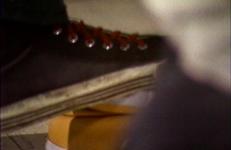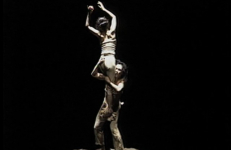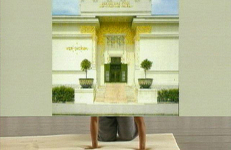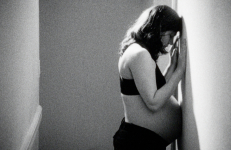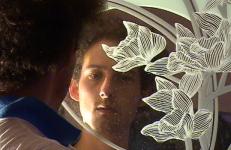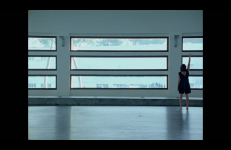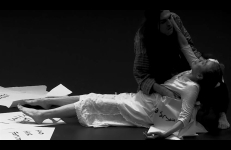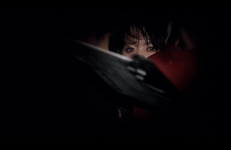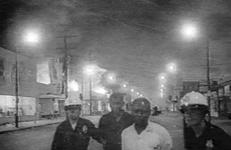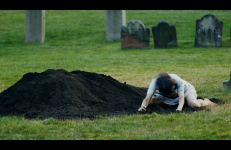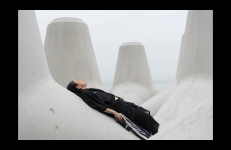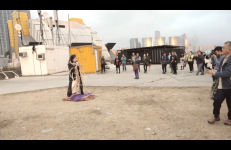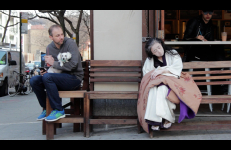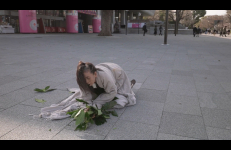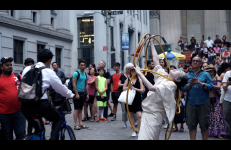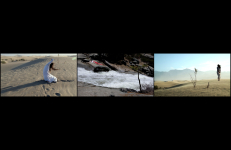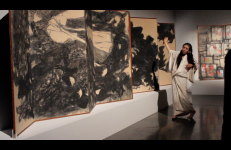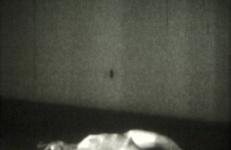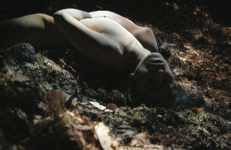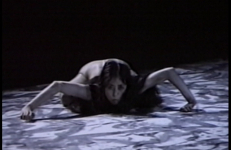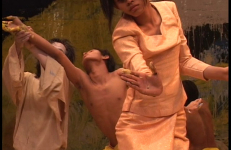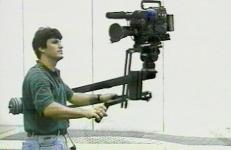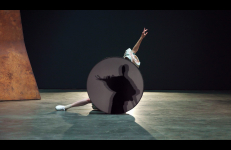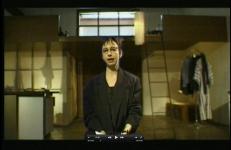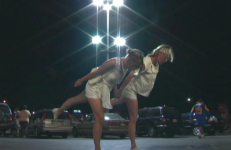Joan Logue cuts down considerably Andy Warhol’s projection of fifteen minutes of fame, with this compilation of 30-Second Spots. Produced to be broadcast as individual, mini-documentaries on the included artists and their work, Logue’s short interpretive video pieces feature a prime time selection of over twenty New York performance artists, composers, dancers and writers, including Maryanne Amacher, Robert Ashley, David Behrman, John Cage, Lucinda Childs, Douglas Ewart, Simone Forti, Jon Gibson, Philip Glass, Spalding Gray, Joan Jonas, Bill T.
Dance
This video was produced as a part of Eiko & Koma's exhibition Time is not Even, Space is not Empty which opened at the Zilkha Gallery in Wesleyan University in the fall of 2009. Edited by Eiko with assistance of Tara Kelton and Shoko Letton, 38 Works shows the trajectory of Eiko & Koma's career through short excerpts of most of their works created between 1976 (the year they arrived in the US) and 2009 (the year they started the Retrospective Project).
Yvonne Rainer combines a dance performance she choreographed for Mikhail Barryshnikov’s White Oak Dance Project in 2000 with texts by Oscar Kokoschka, Adolf Loos, Arnold Schoenberg, and Ludwig Wittgenstein—four of the most radical innovators in painting, architecture, music, and philosophy to emerge from fin-de-siècle Vienna.
Alex and José is a 16mm single channel projection that explores gender, movement and form.
Music: Zeena Parkins
Masked men prowling in the bushes and not touching anything but satin, dandelions and flesh.
Anna Pina Teresa reinterprets the pivotal scene in Rossellini’s Roma Città Aperta where Anna Magnani, who plays the character Pina, (based on the story of Teresa Gullace,) is murdered on the streets of Rome by the Fascist police. This scene is characterized by three movements performed by Magnani — resistance, running and falling. Filmed in the Sala Scherma at Foro Italico in Rome (Mussolini’s fencing studio designed by Moretti) Anna Pina Teresa examines the contemporary and historical dynamics between an urban Fascist space and movements of resistance.
“Trypps Number Three transports the documented transcendence of Jean Rouch's Les Maîtres Fous from the Hauka movement to a Lightning Bolt concert where overlapping bodies, swaying to noise rock, are framed in light beamed from the stage - we return to the models of Caravaggio or Garrel - bodies effectively transformed into islands of individual gestures and expressions via a spotlight and lingering camera, before the film cryptically bends upon itself: henceforth the image (through slow-motion effect) and sound (through Joseph Grimm's spacey
Subtitled A Rebellion against the Commodity, this engaged reading of the urban black riots of the 1960s references Guy Debord’s Situationist text, “The Decline and Fall of the Spectacle-Commodity Economy,” Internationale Situationniste #10 (March 1966). Along with additional commentary adapted from Barbara Kruger and musicians Morrissey and Skinny Puppy, the text posits rioting as a refusal to participate in the logic of capital and an attempt to de-fetishize the commodity through theft and gift.
A Body in a Cemetery is a 15-min short film that documents a place-inspired solo performance by dancer/choreographer Eiko Otake in Green-Wood Cemetery, the U.S.’s second oldest cemetery in Brooklyn that holds 570,000 "permanent residents." Presented in September 2020 by Pioneer Works and Green-Wood Cemetery, this event was for many the first time attending a live performance since the pandemic shutdown.
A Body in Fukushima is a film created by dance artist Eiko Otake consisting of still photographs, inter-titles, and an original score. Photographs are selected from tens of thousands taken by historian/photographer William Johnston of Otake alone in the surreal landscapes of post-nuclear meltdown Fukushima, Japan. Otake edited the film and sound, which includes original music by Kronos Quartet’s David Harrington.
M+ Museum presented A Body in Hong Kong in two locations as part of Mobile M+: Live Art, 2015. The second site she chose and performed at on December 11 and 12, 2015 was the West Kowloon Cultural District, the site where the M+ Museum would be built. Eiko perhaps covered a longer distance in this performance than any other in the past. This raw landscape, rather unusual in Hong Kong, and its political tenderness play as a background of her performance. A Body in Hong Kong is part of Otake’s ongoing project, A Body in Places.
During February and March of 2016, Danspace Project presented Platform, a month long curated program for which Eiko's solo project, A Body in Places, was the focus. At the center of the Platform's dense programs were Eiko's daily solos. Eiko presented 21 performances of A Body in Places in different locations at different times of day and night. In A Body in the East Village, both the camera and the gaze of the audience members closely follow three of these intimate and spontaneous performances.
Eiko Otake, based in the United States since 1976, is a highly regarded artist who has performed in many countries as part of the performance duo Eiko & Koma. Her solo project A Body in Places has attracted much attention since it began in 2014, and she performs it for the first time in Japan.
Eiko Otake performed a version of her solo project, A Body in Places, as a part of River To River Festival on Wall Street. A Body on Wall Street won “Best Use of Location” for Round 3 of Dare to Dance in Public (D2D) Film Festival in 2020.
Camera by Alexis Moh.
Conceived, performed, and edited by Eiko Otake.
This video shows the design and choreography of Eiko's three-channel installation on one screen. Each video was shot in California by Alexis Moh and Marjorie Hunt during a creative residency at UCLA in April 2019.
In a gallery, three sequences are projected on three different adjacent walls or shown on three monitors separately. Eiko "choreographed" 17-min sequences of three videos, considering the overall dynamic and how they are aligned. This is a shortened version.
Documentation of Eiko performing in the installation space is available by request.
For the November 13, 2015 opening of the Hiroshima Panels by Iri and Toshi Maruki at Pioneer Works, Eiko performed her solo in honor of the Hiroshima Panels and their creators. Japanese-style painter Iri Maruki, born in Hiroshima, and Western-style painter Toshi Maruki, who went into Hiroshima city just three days after the bombing. The artists decided to paint the panels together, which illuminate the human experiences of the Atomic Bomb. They spent 30 years painting the fifteen Hiroshima Panels, six of which were on display at Pioneer Works in Red Hook, Brooklyn.
This slow-motion film is a glass snow globe with dancers who topple and bounce off the sides of the frame. Re-purposed by Breder at his Dortmund retrospective as Weisse Tasse in which a video was projected on the side of a white cup.
Filmed in June 1998 at the Whitney Museum of American Art and produced by the New York Public Library for the Performing Arts/Dance Collection. Breath is a creative archive project of Eiko & Koma’s living installation of the same title commissioned by the Whitney Museum. For the living installation Breath, Eiko or Koma was in the installation during all hours that the museum was open.
Commissioned by Boston Dance Umbrella, this work was created during a month-long residency in Boston. Clayton Campbell painted a mythological scene of the river that a dying person crosses to reach the world of the dead. The piece was first titled as Eye Below but later changed to By The River.
Cambodian Stories is Eiko & Koma's multi-disciplinary collaboration with Reyum Painting Collective, young painters who study and work at the Reyum Institute of Arts and Culture in Phnom Penh, Cambodia. In addition to Eiko & Koma, who perform alongside their Cambodian artist colleagues, the creative collaborators include Reyum Institute founder Daravuth Ly, who functions as dramaturg, and Cambodian-born music ethnologist Sam-Ang Sam.
The union of humankind and the camera is a long and sordid tale. This lyrical dance illustrates the inseparable nature of the two.
This title is also available on Animal Charm Videoworks: Volume 3, Computer Smarts.
Circles cycle and shift in scale in this video about, through, into and out of Carol Bove’s monumental sculptures starring the exquisitely talented dancer Katie Gaydos. Circles are celestial bodies, the pendulum, the metronome, playing against the hands of a clock as Gaydos’ body traverses the forest of Bove’s sculptures, reminding us that time is nothing external, but an integral feature of our interior landscape. Bove’s title Chimes at Midnight is a reference to Orson Welles’ film of the same name.
Circle's Short Circuit is an experimental feature-length work with neither a beginning nor an end—the film can be viewed from any random point. It moves through a circle of five interlocking episodes that describe the phenomenon of interruption in contemporary communication through various forms and modes, investigating causes, consequences, and side-effects. Genres shift along the episodic path of this circle, moving from documentary to essay, through collage, simulated live-coverage, and silent film.
C.L.U.E. (color location ultimate experience), Part 1 is a collaborative video and performance work by artists A.L. Steiner and robbinschilds, with AJ Blandford and Seattle-based band Kinski. Inhabiting the intersection of human movement and architecture, A.L. Steiner and robbinschilds (Sonya Robbins and Layla Childs) present a full-spectrum video, set to a score by rock quartet Kinski.




